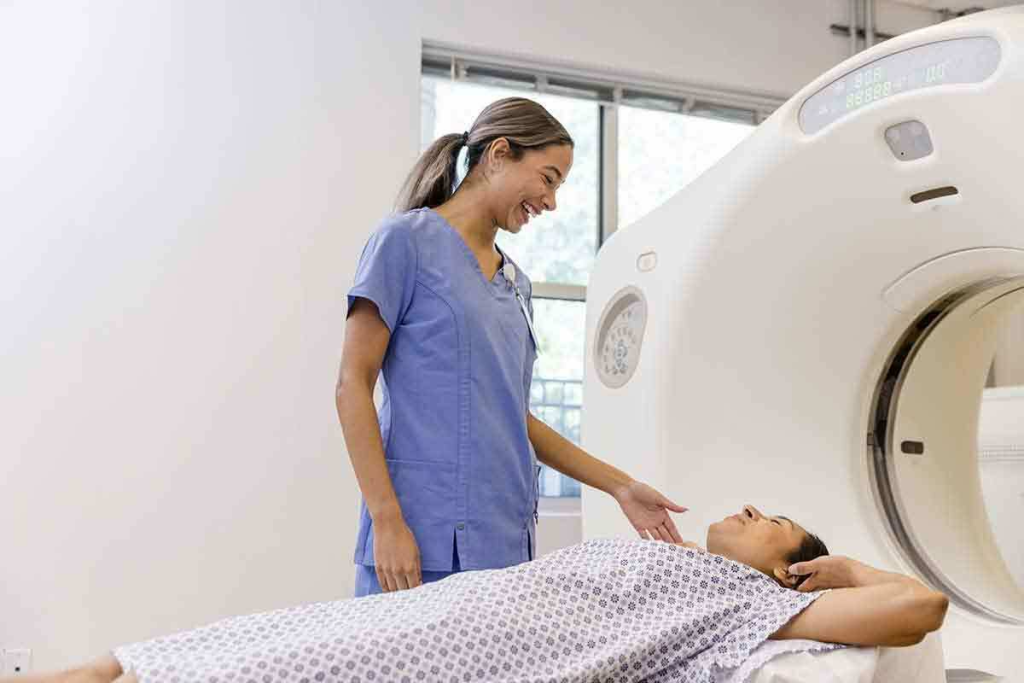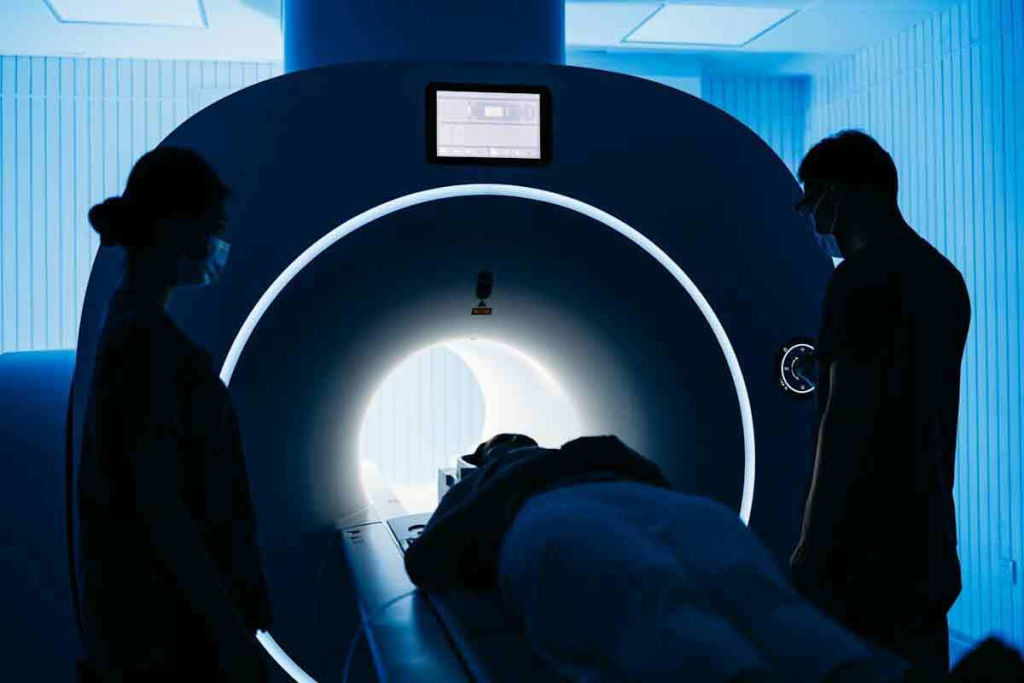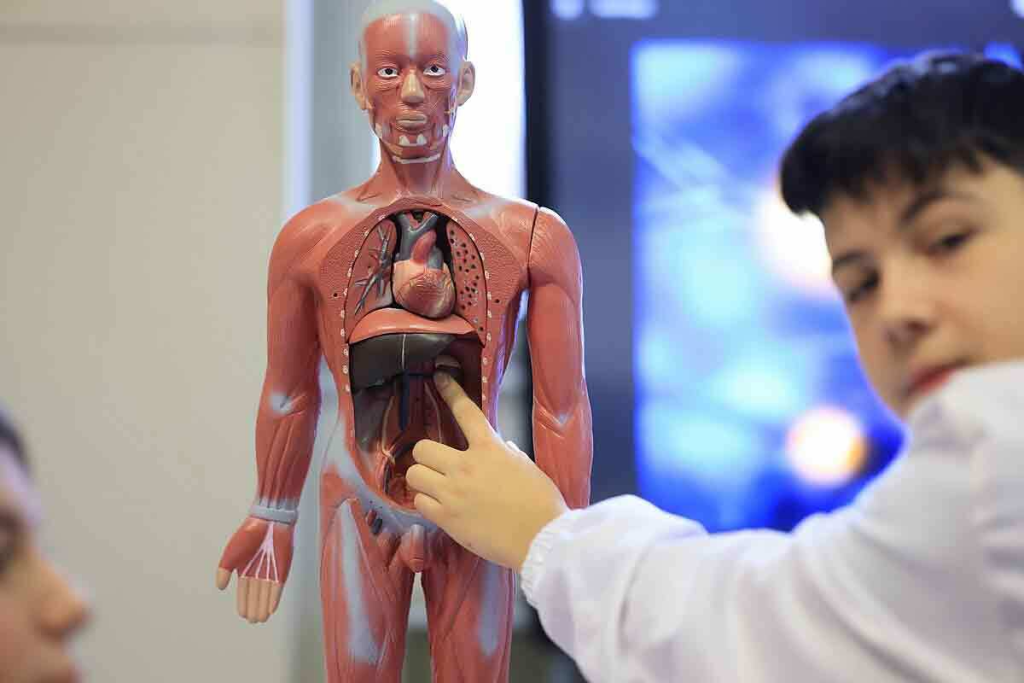
At Liv Hospital, we know patients worry about CT scans if they have metal implants. CT scans use X-rays to make detailed images. They are often done on patients, even those with metal in their body.
Having metal in a CT scan can make images blurry around the metal, a phenomenon known as metal artifacts. But, it’s not as risky as MRI, which uses strong magnets. Most metals, like implants, dental work, and joint replacements, don’t stop a CT scan. Yet, images near the metal might not be as clear. This situation is often referred to as a “ct scan with metal in body” issue, where metal can cause streaks or dark lines on images, potentially obscuring details. Newer technologies and software like Metal Artifact Reduction (MAR) help minimize these effects and improve image quality for better diagnosis.
r.

A CT scan is a high-tech X-ray machine. It takes many images from different angles. This creates a detailed picture of the body’s inside parts. We use CT scans to find many medical problems, from injuries to complex diseases.
CT scans show more detail than regular X-rays. They are different from MRI or ultrasound. MRI uses magnetic fields, while CT scans use X-rays. This makes CT scans better for some diagnoses.
In a CT scan, X-rays are sent from many angles around the body. The scanner’s sensors catch these X-rays. Then, a computer makes images from these X-rays into detailed slices.
Using contrast materials makes these images clearer. These materials highlight certain areas or structures. This helps doctors diagnose conditions more accurately.

Metallic objects in the body come from many sources. These include surgical implants, dental fillings, and orthopedic hardware. These metals can affect how medical imaging works, like CT scans.
Surgical implants and prosthetics are common sources of metal in the body. This includes pacemakers, artificial joints, and surgical clips or staples. For example, hip replacements often have metal parts that can impact imaging.
Dental work, like fillings, crowns, and bridges, also contains metals. While they are smaller than implants, they can cause problems in CT scan images.
Orthopedic hardware, like plates, screws, and rods, and joint replacements are also made of metal. These are usually made from titanium or stainless steel. They are chosen for their strength and how well they work with the body.
The table below shows common metals in the body and how they might affect CT scans:
| Type of Metal | Examples | Potential Impact on CT Scans |
| Surgical Implants | Pacemakers, artificial joints | May cause artifacts or distortions |
| Dental Work | Fillings, crowns, bridges | Can cause minor artifacts |
| Orthopedic Hardware | Plates, screws, rods, joint replacements | May significantly affect image quality |
Knowing what metals are in your body is key before a CT scan. Tell your healthcare provider about any implants, dental work, or orthopedic hardware. This helps make sure the scan goes well and images are clear.
When you get a CT scan with metal in your body, several things can affect the images. We know metal implants or objects can worry you during a CT scan. We aim to make you understand what happens during this test.
Metal artifacts are distortions in CT scan images caused by metal objects or implants. They can look like streaks, shadows, or bright spots. These can hide important details in the images.
The type and size of metal, and where it is in your body, affect how bad these artifacts are. For example, dense metals like titanium or stainless steel can cause bigger problems than less dense materials. Knowing about these artifacts helps radiologists understand the images better.
Radiologists are trained to read CT scan images, even with metal in them. They use special techniques and software to lessen the impact of metal artifacts. Our radiologists are experts at dealing with these challenges, making sure you get the right diagnosis.
To improve image reading, radiologists might change the scan settings or use new algorithms. This helps them see past metal artifacts and focus on what’s important. Their skill ensures patients with metal implants get the right care.
We know getting a CT scan with metal can be worrying. But with our advanced tech and skilled radiologists, we’re ready to help. We provide the care you need, even with metal in your body.
It’s important to know how metal implants affect diagnostic imaging choices. This is because it impacts whether to use CT scans or MRIs. Many people worry about the safety of these tests with metal in their bodies.
MRIs use strong magnetic fields to see inside the body. But, these fields can be dangerous with certain metals. This can cause the metal to heat up or move, which might harm the patient.
The risks of MRI scans with metal implants include:
CT scans, which use X-rays, are safer for people with metal implants. Unlike MRI, X-rays don’t cause metal implants to heat up or move. This makes CT scans a safer choice for many.
But, CT scans can also have metal artifacts. These can affect image quality. New techniques help reduce these issues, keeping the images clear and useful for doctors.
Let’s compare the safety of CT scans and MRIs for people with metal implants:
| Imaging Test | Safety with Metal Implants | Potential Risks |
| CT Scan | Generally Safe | Image artifacts |
| MRI | Conditional Safety* | Heating, movement, image artifacts |
*Conditional safety depends on the type of metal implant and its compatibility with MRI.
In summary, CT scans are safer for people with metal implants than MRIs. Knowing these differences helps make better choices for diagnostic imaging.
If you have metal implants or other internal metal, getting ready for a CT scan is different. It’s key to tell your healthcare provider about any metal in your body. This ensures the scan is safe and effective.
Before your CT scan, tell your healthcare provider about any metal implants or devices. This includes things like surgical implants, prosthetics, dental work, and orthopedic hardware. Giving them this info helps them prepare and take the right steps.
Also, mention the type of metal in your implants. Different metals can affect how clear the CT scan image is. Knowing this helps your healthcare team adjust the scan to get the bet results.
“It’s vital to tell your healthcare provider about any metal implants or devices before a CT scan. This ensures your safety and the quality of the imaging.”
Medical Imaging Expert
Bringing documentation about your metal implants can make the CT scanning process smoother and safer. This might include medical records, implant cards, or letters from your surgeon. Having this info on hand helps your healthcare provider understand your situation better.
| Documentation Type | Description | Importance |
| Medical Records | Detailed history of your medical procedures and implants | High |
| Implant Cards | Identification cards provided with your implant | High |
| Letters from Surgeons | Detailed information about your implant procedure | Medium |
Before a CT scan, many wonder if they can wear metal. Metal, inside or outside the body, can impact the scan. Internal metal comes from implants or surgeries, but external metal is usually easier to take off.
Jewelry and accessories with metal are a big concern. This includes earrings, necklaces, rings, and piercings. We tell patients to remove these items to avoid image problems.
Removing these items ensures clearer images and safety. Some jewelry might get hot or cause issues, more so with MRI scans.
“It’s key for patients to tell us about any metal implants or items they’re wearing. This ensures their safety and the quality of the CT scan images.”
Medical Expert
Clothing with metal parts, like zippers or buttons, should be changed or removed. Wearing simple, metal-free clothes is best to avoid problems.
Also, take out dentures and partials before the scan. This helps get clear images of your mouth and prevents discomfort.
| Item | Action Required | Reason |
| Jewelry and Piercings | Remove | Prevents image artifacts and ensures safety |
| Clothing with Metal | Change or Remove | Avoids image distortion |
| Removable Dental Work | Remove | Ensures clear imaging of oral structures |
In summary, while internal metal needs special care in CT scans, external metal should be removed. This helps get clear images for better diagnosis and treatment.
When metal is in the body during a CT scan, it can really mess up the image quality. This happens because metal interacts with the X-rays in a way that distorts the images.
Metal objects can cause weird artifacts and distortions in the images. This might lead to misreading the images or needing more scans. It’s important for both doctors and patients to know about these effects to get the best results.
Metal artifacts in CT scans can show up in different ways. Here are a few examples:
These distortions can hide important details, making it hard to diagnose some conditions.
To lessen the impact of metal on CT scan images, new techniques and technologies have been created:
| Technique | Description | Benefits |
| Metal Artifact Reduction (MAR) Software | Advanced algorithms that process images to reduce metal artifacts | Improved image quality, enhanced diagnostic accuracy |
| Dual-Energy CT Scanning | Uses two different X-ray energy spectra to improve material differentiation | Reduced artifacts, better visualization of structures near metal |
| Iterative Reconstruction Techniques | Advanced image reconstruction methods that reduce noise and artifacts | Improved image clarity, reduced need for repeat scans |
These advancements in CT scanning technology help doctors get clearer, more accurate images. Even when metal is present.
By knowing how metal affects CT scan images and using these new techniques, we can improve diagnosis and patient care.
Having metal in your body during a CT scan raises concerns about radiation and image quality. We know that getting a CT scan can be scary, even more so with metal implants or prosthetics.
CT scans use ionizing radiation, which is a big deal. The amount of radiation you get depends on the scan type, body part, and the facility’s protocol. Usually, the dose from a CT scan is between 2 to 10 millisieverts (mSv). This is about the same as the yearly background radiation most people get.
We make sure the radiation dose is as low as possible while getting good images. We work hard to keep radiation exposure down, even more so for those with metal implants.
Metal in your body can change how radiation is absorbed during a CT scan. Metal artifacts happen when metal absorbs or scatters X-rays, causing image problems. This might make the images less clear and sometimes needs extra scans or special techniques.
But, it’s important to know that metal doesn’t always ruin the images. Today’s CT scanners and new algorithms help reduce metal artifacts. We carefully scan patients with metal implants, adjusting our methods to get the best results.
CT scanning technology has made big strides for patients with metal in their bodies. It uses special protocols to get the best results. Metal can mess up CT scan images, which might lead to wrong diagnoses or more scans.
To fix this, modern CT scanners and software use many strategies. They aim to improve image quality.
Different metals need different scanning methods. For example, patients with metal implants might get scans with special X-ray beam settings. This helps reduce metal artifacts.
We also use dual-energy CT scanning. It can tell different materials apart and make images clearer.
Key modified scanning techniques include:
Advanced software is key in reducing metal artifacts in CT images. Modern CT scanners have smart algorithms to lessen metal’s impact on image quality. These software tools can make images clearer by reducing artifacts.
Some of the software solutions include:
By mixing modified scanning techniques with advanced software, we greatly improve CT scans for patients with metal implants. This boosts diagnostic accuracy and helps in better treatment planning and patient care.
Patients with metal implants or prosthetics often worry about CT scans. They might think the metal in their body is a problem. We’ll clear up some common fears and myths about CT scans and metal.
Many patients worry if metal in their body will affect the CT scan. They might think it will mess up the scan’s accuracy. But, CT scans are made to work safely with most metal implants.
Safety considerations include:
There are many myths about CT scans and metal that need to be debunked. For example, some think metal in the body always makes CT scans useless. But, this isn’t always true.
Common myths include:
We’re here to give you accurate info and reassurance. Our goal is to make sure you feel comfortable and informed during your diagnostic journey.
Healthcare providers might suggest other imaging methods when metal implants are involved. At Liv Hospital, we know that patients with metal implants need special diagnostic plans. This ensures accurate and safe imaging.
In some cases, MRI or ultrasound might be better than CT scans for patients with metal implants. For example, if a patient has a big metal implant or certain surgical clips, MRI could be used. This is true even with some metal implants, as long as they are MRI-compatible.
Ultrasound is a safe choice that doesn’t use radiation. It’s also safe for patients with metal implants because it doesn’t have strong magnetic fields. We look at each patient’s situation to pick the best imaging method.
Our highly trained professionals focus on advanced imaging services for patients with metal implants. Our team works with doctors to find the best imaging plan. We consider the metal implant type, its location, and the patient’s health.
We use state-of-the-art technology to reduce metal artifacts. This ensures our patients get accurate diagnoses. We assess each patient’s medical history and metal implant details to choose the right imaging.
We aim to provide top-quality care that fits each patient’s needs. Whether it’s a CT scan or MRI/ultrasound, we’re committed to personalized diagnostic solutions.
Knowing about metal in your body during a CT scan is key for a safe experience. We’ve looked into how CT scans work and the effects of metal on them. This knowledge helps you feel more confident during a scan, even with metal implants.
Preparation is key when you have metal in your body for a CT scan. It’s important to tell your healthcare provider about any metal implants or objects. This helps ensure the scan is done safely and accurately, reducing any metal-related issues.
With the right steps and the help of skilled healthcare teams, you can face a CT scan with confidence. Places like Liv Hospital use advanced methods to handle patients with metal implants. This ensures you get the best diagnostic images possible.
No, it’s best to remove all metal items, like jewelry and piercings, before a CT scan. This prevents image distortion.
Metal implants can cause image distortions in CT scans. But, radiologists are skilled in handling these issues. They use advanced techniques to improve image quality.
Generally, yes, CT scans are safe for people with metal implants. But, tell your healthcare provider about any metal in your body. This ensures they take the right precautions.
Usually, no, you don’t need to remove dental fillings or most dental work. But, tell your healthcare provider about your dental work. They’ll check if it might affect your CT scan.
Metal might affect how radiation is absorbed. But, modern CT scanners and radiologists adjust for this. They ensure your scan is safe and effective.
Yes, sometimes, MRI or ultrasound might be suggested for patients with metal implants. Your healthcare provider will choose the best imaging method for your condition.
Tell your healthcare provider about any metal implants or dental work. Bring any documents about your metal implants. This helps your healthcare team prepare for your CT scan.
Not telling your healthcare provider about metal could cause image distortion. It might also require more scans. This could delay your diagnosis. Always tell your healthcare provider about any metal implants or work.
Yes, you can have a CT scan with orthopedic hardware or joint replacements. While these metals can cause artifacts, advanced CT scanning techniques can minimize their impact on image quality.
No, a CT scan will not damage your metal implants. CT scans are a safe imaging modality for individuals with metal in their bodies.
Subscribe to our e-newsletter to stay informed about the latest innovations in the world of health and exclusive offers!
WhatsApp us